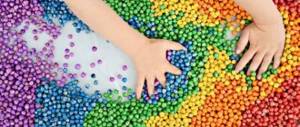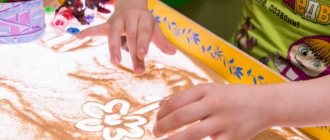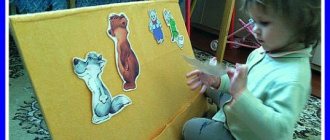Card file of sand games
In such games, you can use tasks to classify objects, for example - only geometric shapes, only animals.
Game “Who came to us?”
Goal: development of visual and tactile perception.
Content.
The child turns away, the adult makes bas-relief/high-relief prints using the molds, then the child guesses the mold the adult used. Then they change roles. The molds are first inspected and felt, and their contours are outlined. To complicate the task, play with new molds without first feeling them.
Game "Winner of Anger"
Goal: relieving psycho-emotional tension, getting to know emotions.
Content.
In a stressful situation, adults say to each other, and sometimes to children: “Don’t be angry, don’t be capricious, pull yourself together.” In most cases, this advice is completely meaningless, since a ban on the manifestation of negative emotions only causes a person to become additional irritated and aggressive towards the adviser and increases the feeling of guilt for “bad behavior.”
The game “Anger Conqueror” can teach a child to deal with anger painlessly for his pride, without fear of punishment for destructive behavior.
Today we will talk about mood. What is it like for you? What happens to you when you are angry, angry? What do adults say and do when you are angry? (Child's answers.)
Your angry mood makes you do and say things that make adults angry and upset. And after the anger has gone, you feel sad or unpleasant. I’ll tell you a secret - every big and small person has the right to be angry. There are many games that teach us to “get angry the right way,” that is, in a way that doesn’t offend others. Wet sand will give you one of these games. See how you can use sand to sculpt and see your own anger, and then defeat it. (If the child’s tension is too great, then in this case you can ask him to squeeze the sand forcefully, compact the surface of the sand with his fists, etc.)
The child, following the example of an adult, makes a ball out of wet sand, on which he marks with indentations or draws eyes, nose, mouth: “Your anger now lives in this ball.” This process temporarily switches the child, and the child also transfers his negative feelings and guilt for “bad behavior, thoughts, feelings” to the sculpted ball. An older preschooler can comment on the entire process of making the “evil ball,” to which all evil thoughts and actions are ultimately assigned.
Then the child destroys the sand ball in any way, saying a magic spell: “Drive away anger, invite joy.” The baby provides an outlet for aggression, which usually appears when it is prohibited and controlled by an adult; he also receives specific pleasure from destruction. After this, the child slowly levels the surface of the sand with his hands and leaves imprints of his palms on it - calming, gaining balance and control over his own feelings: “I conquered my anger. I am calm". If desired, the child can decorate their handprints in the sand.
consultation for parents “Playing with sand and water at home”
CONSULTATION FOR PARENTS
“GAMES WITH SAND AND WATER AT HOME”
Playing with water creates a joyful mood in children, increases vitality, and gives children a lot of pleasant and useful impressions, experiences and knowledge.
These water games can be organized at home with children.
1. Introduction to the properties of water:
Water spills, it is liquid. It can be collected with a cloth or sponge.
Water can be hot, warm and cold. Try it by touch.
The water is clean, transparent, you can see everything through it. Compare a glass of water with a glass of milk.
The water doesn't smell. She has no smell. Let the children smell it.
Water can be poured and poured. Give children the opportunity to pour the water themselves.
Water can be colored by adding a dye (tea, coffee, gouache, brilliant green).
2. Pouring water into different containers (spoon, lid, jar, mug).
3. Pouring water into different vessels (cup, bottle, jar, saucepan.).
4. Fun fishing (catch different objects from containers of different sizes with a spoon).
5. Drowning - not drowning (games for experimentation).
6. Games with soap bubbles. (Independently blowing bubbles. Catch the bubble in the palm of your hand. Whose bubble is bigger? Whose bubble will fly higher, further.? .)
7. Games with wind-up floating toys.
8. Games with small rubber, plastic and wooden toys.
9. Games with a doll: “Let’s wash the doll”, “Let’s give our doll a bath”, “Let’s wash the doll’s dishes”, “Let’s wash the doll’s clothes”.
In the future, you can organize various snow observations.
1. Bring snow home in a bowl and observe what happens to it in the warmth. Snow is water.
2. Pour water into the mold and take it outside on a frosty day. At the end of the walk, see what happened to the water. Ice is frozen water.
3. Examine the water after the snow melts. What can you see at the bottom of the saucer? Snow is dirty, you can't eat it.
4. Take a piece of ice from the refrigerator. Hold it in your hands. What are your hands like? (wet). Ice is water.
5. Place the icicle on the grill. What happens to her in the heat? She began to melt in the warmth.
For playing with sand, it is advisable to have a sand set: a bucket with scoops and molds; a set of small toys: fairy tale characters and various little men, animals and plants, houses and cars, wooden planks and sticks, etc.
This collection must be constantly updated. We can play these games with children:
- We're playing shop. Teach children to make “products” from sand for the store - ice cream, cake, pies, sausage, etc.
— We are building a house. Teach children to shovel sand into a pile and gently pat it down. Decorate the house with flags, insert windows and a door.






